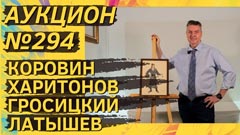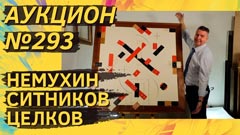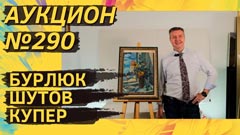
1960s UNOFFICIAL ART
SVESHNIKOV Boris Petrovich (1927–1998) Walk. 1986. Oil on canvas. 70 × 60
1986 creation year. Soft, dense elaboration, the kind of thing especially appreciated by collectors. At the same time, a powerful, but not “extreme” plot in the Sveshnikov manner. Finally, the publication. This painting is reproduced in Valery Dudakov's catalog “Boris Sveshnikov. Free in the World of Non-Freedom”. Absolutely museum level and an ideal investment object.
What many consider Sveshnikov's Kafkaesque romance is actually a sublimation of the difficult and traumatic memories of his youth. At 19, he was arrested on a trumped-up case of preparing an assassination attempt on Stalin and sent to the camps almost to certain death. Sveshnikov quickly lost his health and was driven to the brink of madness by starvation and disease. But he survived by a miracle thanks to the help of his friends, and his drawing sessions helped him keep his sanity. The works of the 1980s are considered by many connoisseurs to be the pinnacle of Sveshnikov's art. His phantasmagorias were becoming more and more complex in terms of subject, and painting was reaching the highest degree of elaboration.
VULOKH Igor Alexandrovich (1938–2012) Gray background. 1989. Oil on hardboard. 80 × 70
A very recognizable, inspired, concise abstract landscape-reflection by the sixties artist Igor Vulokh. Vulokh is an aesthetic nonconformist. He studied at the VGIK until he was expelled for professional misconduct in 1961 as punishment for an exhibition uncoordinated with the authorities. Today, Vulokh's works are in the collections of the country's major museums and important private collections, including those of the Semenikhins, Alshibai, Kurtzer, and others.
“Gray background” is a work of stunning beauty. The jewel in the collection. In addition, such Vulokh's subjects extremely rarely appear at auction. Do not miss. The authenticity is confirmed by the artist's widow, Natalia Okhota.
NEIZVESTNY Ernst Iosifovich (1925–2016) Trotsky. Revolutionary of all times. 1999. Paper, pastel, pencil, mixed media. 101 × 81
Trotsky and Stalin. The “knight of the revolution” and the insidious tyrant. Bright tribune and “unsightly Caucasian”. Organizer of the October Revolution and “number two”. But in the end — the victim and murderer. Recent comrades-in-arms in the revolutionary struggle, they quarreled during the Civil War. And in the late 1920s they became sworn enemies and political adversaries. Stalin forced Trotsky into hiding in exile, organized several assassination attempts, and waited for the hired agent Ramon Mercader to do his job. Trotsky died from a blow with an ice pick in Mexico in 1940. Two years before that, Stalin had repressed his wife and children. All four of Trotsky's children, most of his family members were shot or died under suspicious circumstances. Mercader, who murdered Trotsky himself, was awarded the Order of Hero of the Soviet Union.
Stalin hated Trotsky as the most likely successor to Lenin. The chairman of the Revolutionary Military Council, Trotsky was popular with both the army and the party leadership. The son of Jewish landowners who had no military education, he defeated the genteel White Guard with a workers' and peasants' army. On talent, on cunning, on political instinct and on cruelty. He took the families of officers hostage, forcing them to join the Red Army. Disappointed in the discipline of the workers' and peasants' army, Trotsky introduced barrier troops and restored the monstrous practice of shooting one in ten. The knight of the revolution had his hands up to his elbows in blood. The war was fought to the annihilation. It was necessary to win at all costs. If you lose, there would be no mercy.
In Trotsky's fate, there were strange encounters with people of art. For example, one of the assassination attempts on him was led by the famous Mexican Stalinist painter Siqueiros. He and his conspirators fired a hundred bullets into Trotsky's bedroom. But the politician remained unharmed, hiding under the bed. Well, another well-known fact reflected in art and cinema is the affair of the ideologist of the Fourth International with the famous artist Frida Kahlo.
Artist and sculptor Ernst Neizvestny is a major figure in post-war unofficial art. He was the creator of the 75-meter monument “Lotus Flower” in Egypt, “Masks of Sorrow” in Magadan, “Tree of Life” in Moscow and others. The authenticity of the pastel “Trotsky” was confirmed by the artist's daughter, Olga Neizvestnaya.
YAKOVLEV Vladimir Igorevich (1934–1998) Two white flowers on a black background. 1975. Paper, gouache. 57 × 42 (in light)
Such touching gouaches by Yakovlev hung in Khrushchev houses and panel new buildings of the Soviet intelligentsia — engineers, doctors, scientists, musicians. Vladimir Yakovlev suffered from mental illness from his youth, spent many years in psychiatric hospitals and nursing homes, at the end of his life he was almost completely blind. But today in front of us is an unconditional creative success: a good year, a valuable period, the main plot, virtuoso performance. The work is signed and confirmed by the expertise of Valery Silaev.
KRASNOPEVTSEV Dmitry Mikhailovich (1925–1995) Destroyed Warsaw. 1954. Oil on canvas. 26.5 × 33.5
The appearance of this work at our auction was pleased with Alexander Ushakov — the main specialist on the work of Krasnopevtsev. It turned out that “Destroyed Warsaw” is mentioned in the artist's notes, it was searched for, and now it will be possible to make high-quality photos. And so another cell will be covered in the future catalogue raisonné of Dmitry Krasnopevtsev. 1954 is still early Krasnopevtsev, when his friends called him “Russian Rembrandt”. He was not yet an innovator of metaphysical still life. But the ruins, the atmosphere of the Middle Ages, were already a world in which the artist felt comfortable. Krasnopevtsev often turned to such subjects. Even his landscapes of Moscow's back alleys were reminiscent of the arches and streets of old European cities. In general, we are faced with a rarity. Collector's item. For connoisseurs.
CONTEMPORARY ART
GETA Sergey Andreevich (1951) The Noise of the Sea. 2021. Canvas, acrylic, oil. 110 × 120
Sergey Geta is a well-known representative of Russian hyperrealism. Together with Sergey Bazilev, Alexey Tegin, Sergey Sherstyuk, Igor Kopystiansky, and Nikolay Filatov, he was a member of the group “Six”, which made a splash in the 1970s. “The Noise of the Sea”» is a new, very positive work. And very symbolic for the year 2021, when most people could only see the sea in a picture.
The term “hyperrealism” (super-realism), like “impressionism”, like “severe style”, was born thanks to the pen of critics and art historians. It was first heard in France in 1973. “Hyperrealism” was invented as the name of an exhibition that collected photorealistic works by Chuck Close, Gerhard Richter and other young authors of that time. From the usual photorealism “hypers” are distinguished by the emphasis, highlighting the object, adjusting the “frame” under a general idea. And the picture “The Noise of the Sea” has all these components: the artist has chosen the focus, found the moment, fixed the atmosphere. There is everything. The name, the main theme, the large size — the perfect choice for a strong private collection.
- Log in to post comments










